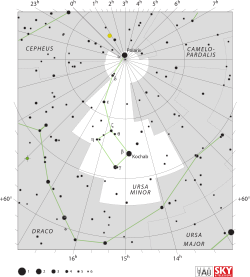Gamma Ursae Minoris
| Observation data Epoch J2000.0 Equinox J2000.0 |
|
|---|---|
| Constellation | Ursa Minor |
| Right ascension | 15h 20m 43.71604s |
| Declination | +71° 50′ 02.4596″ |
| Apparent magnitude (V) | +3.05 |
| Characteristics | |
| Spectral type | A2 III |
| U−B color index | +0.08 |
| B−V color index | +0.09 |
| Astrometry | |
| Radial velocity (Rv) | −3.9 km/s |
| Proper motion (μ) |
RA: −17.73 mas/yr Dec.: +17.90 mas/yr |
| Parallax (π) | 6.70 ± 0.11mas |
| Distance | 487 ± 8 ly (149 ± 2 pc) |
| Absolute magnitude (MV) | –2.84 |
| Details | |
| Radius | 15 R☉ |
| Luminosity | 1,100 L☉ |
| Surface gravity (log g) | 2.53 cgs |
| Temperature | 8,280 K |
| Rotational velocity (v sin i) | 180 km/s |
| Other designations | |
| Database references | |
| SIMBAD | data |
Gamma Ursae Minoris (γ Ursae Minoris, abbreviated Gamma UMi, γ UMi), also named Pherkad, is a star in the northern circumpolar constellation of Ursa Minor. Together with Beta Ursae Minoris (named Kochab), Gamma forms the end of the dipper pan of the "Little Dipper", which is an asterism forming the tail of the bear.
γ Ursae Minoris (Latinised to Gamma Ursae Minoris) is the star's Bayer designation.
It bore the traditional name Pherkad, which derived from the Arabic فرقد farqad "calf", short for aḫfa al farkadayn "the dim one of the two calves", that is Pherkad and Kochab (the full name Ahfa al Farkadain is traditionally applied to ζ Ursae Minoris). Gamma Ursae Minoris was sometimes called Pherkad Major to distinguish it from 11 Ursae Minoris Pherkad Minor. In 2016, the International Astronomical Union organized a Working Group on Star Names (WGSN) to catalogue and standardize proper names for stars. The WGSN approved the name Pherkad for this star on 21 August 2016 and it is now so entered in the IAU Catalog of Star Names.
The fainter Pherkad Minor has been called γ1 Ursae Minoris, in which case Pherkad Major is designated γ2. However this usage is rarely seen.
In Chinese, 北極 (Běi Jí), meaning North Pole, refers to an asterism consisting of Gamma Ursae Minoris, Beta Ursae Minoris, 5 Ursae Minoris, 4 Ursae Minoris and Σ 1694. Consequently, Gamma Ursae Minoris itself is known as 北極一 (Běi Jí yī, English: the First Star of North Pole.), representing 太子 (Tàizǐ), meaning Crown Prince
...
Wikipedia

